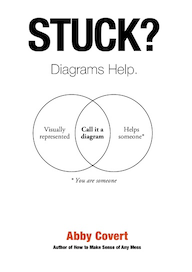- Tags:: 📚Books, ✒️SummarizedBooks, Writing is thinking, Personal Knowledge Management Systems
- Author:: Abby Covert, Jenny Benevento
- Liked:: 4
- Link:: Stuck? Diagrams help. - Abby Covert, Information Architect
- Source date:: 2022-08-21
- Finished date:: 2022-09-17
- Cover::

Why did I want to read it?
One of the major quality of life improvements I’ve experienced is Writing is thinking. So, I’ve always been curious about whether diagrams can improve my thinking even more.
What did I get out of it?
Unfortunately, not much. The book is nice, but it doesn’t really have much to teach if you’ve been in the business of presenting information. That is, perhaps it is too introductory.
VUCA and anxiety
I think the same way about writing. It is the equivalent of the virtual memory of computers, it allow us to work with more:
Diagramas are particularly helpful in grounding us when we feel anxious because we can use diagrams to fly through time and space and consume a fuller picture (p. 19)
Diagramming is a skill we can learn to lean on when there is a swell of volatility, uncertainty, complexity, and/or ambiguity (VUCA) (p. 21)
When we feel a VUCA storm a-brewing, getting the problem out of our heads and onto a page always helps (p. 73)
This is why I think an approach like Canvas doesn’t work:
When we encounter diagrams that are neat and tidy, we get to skip one layer of the anxiety of other people’s diagrams. It’s an immediate lessening of the cognitive load (p. 163).
… diagrams suffer from the same information dilemmas as do all other information architectures: too much information, too little information, not the right information (p. 85)
Related to 📖 Bullshit. Contra la charlatanería:
Richard Saul Wurman coined the term unnecesary exactitude to describe when a data point is needlessly precise for its intention (p. 177
We know shit about diagramming: talk to your audience
Very interesting remarks that you would not expect in a book about diagrams:
Of the studies that have been done, the conclusion is that “a major factor determining a viewer’s capacity to make effective use of a diagram is how much that person already knows about the sort of subject matter depicted in the diagram and the specific method of depiction”. These articles all recommend duplicating all information in text and diagrams (as we do) and insist that diagram literacy must be taught in order to make diagrams usable (p. 304)
Allan Paivio’s dual coding makes me think of the attitude towards documentation of code of Eric Evans in 📖 Domain Driven Design:
There is even empirical evidence of a phenomenon called conjoint retention or dual coding, meaning the combination of verbal and non-verbal representations to facilitate increased retention of information (p. 33)
In most fields and diagrams neither academics nor practitioners have any scientific or codified evidence that diagrams generally help users (p. 306)
Which they intelligently use to insist a lot on iterating your diagram with your intended audience:
… a diagram is only good in the eye of the beholder (p. 69)
Larry Tesler’s law of conservation of complexity states that complexity can’t be removed; it can only be dealt with through user interaction or product development (p. 27)
Practical advice
Interesting meta-diagrams (p. 210):



For flow diagrams (p. 227):

Align labels to directions! (p. 197)

She proposes to start making a diagram just with labels, with no boundaries and no lines (p. 110).
Other notes
An interesting ref: Malcolm Craig book, Thinking Visually (p. 238)